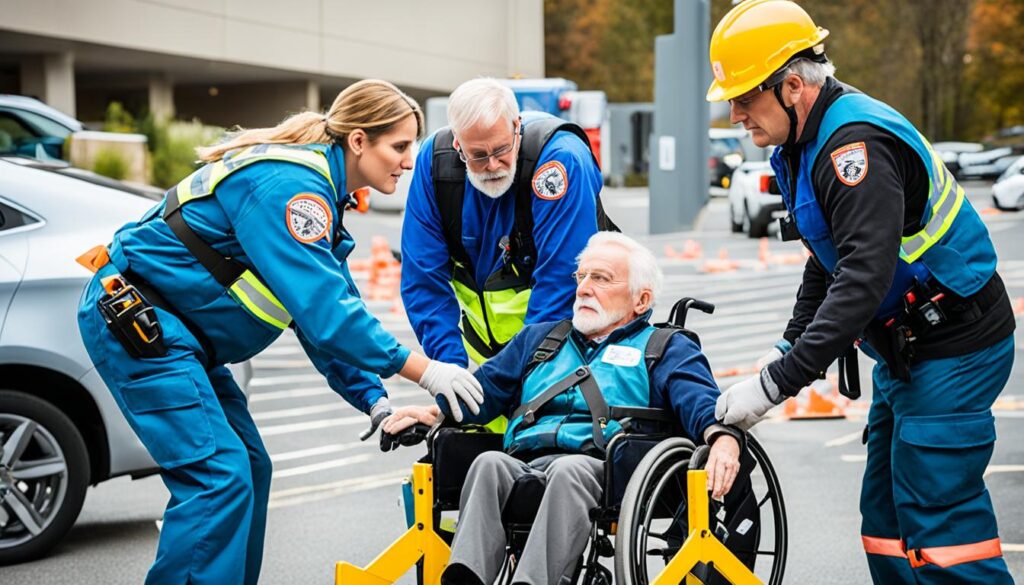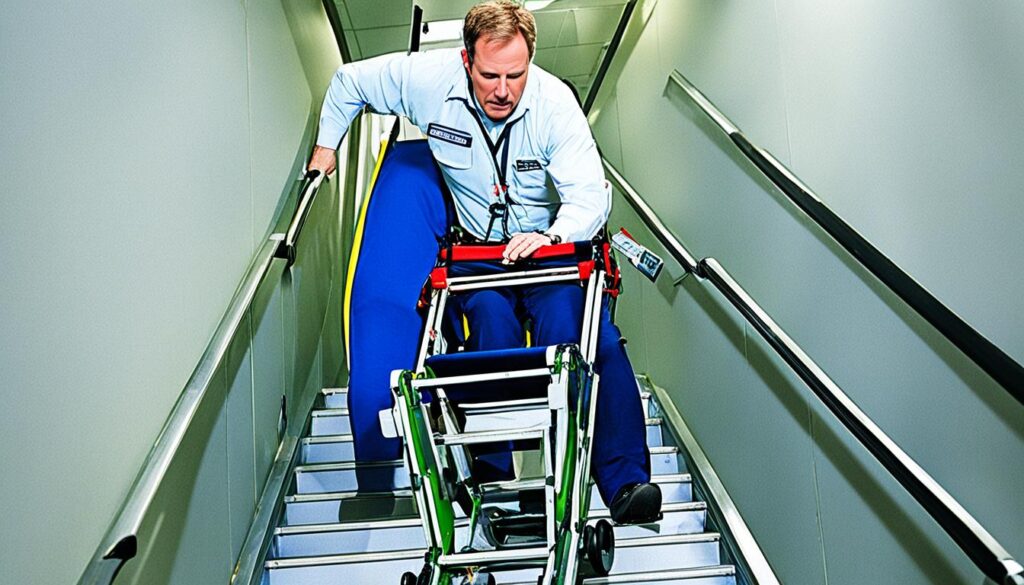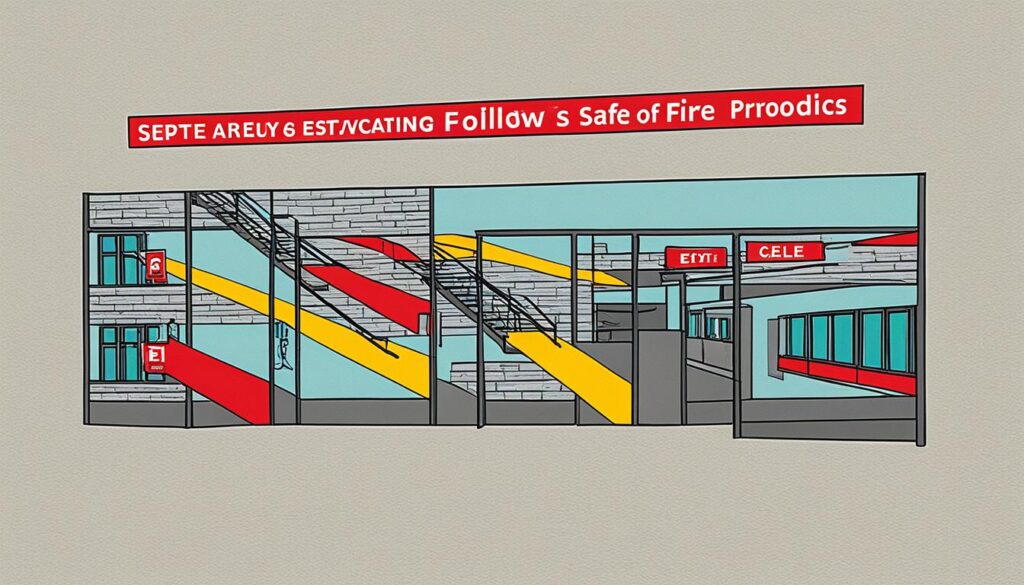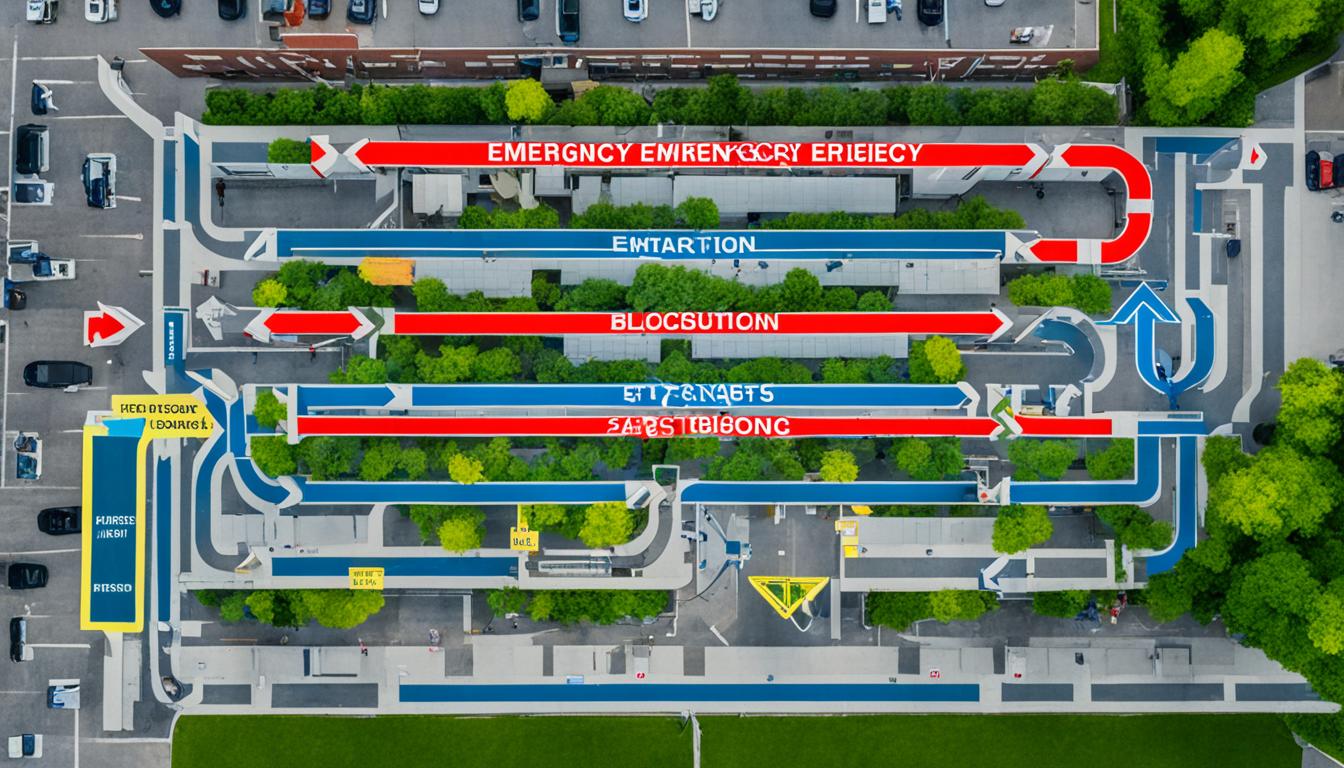Safe Evacuation Protocols Guide | UK Safety Tips
Emergency evacuation protocols are vital for the safety and well-being of individuals in the United Kingdom. In the event of a fire or any other emergency, having effective evacuation plans in place can mean the difference between life and death. Understanding and implementing emergency evacuation procedures and guidelines is essential to ensure a safe and orderly evacuation process.
When it comes to creating evacuation plans, there are several key aspects to consider. Clear escape routes must be established, marked exits should be easily identifiable, and employees need to be trained on emergency evacuation protocols. By following these emergency evacuation guidelines, we can create a safer environment for everyone.
Key Takeaways:
- Emergency evacuation protocols are crucial for ensuring the safety of individuals in the UK.
- Businesses and organizations must adhere to specific guidelines and regulations to create effective evacuation plans.
- Clear escape routes, marked exits, and employee training are essential components of emergency evacuation protocols.
- Special considerations should be made for individuals with mobility needs, such as wheelchair users.
- Assigning staff roles and responsibilities is crucial for a smooth evacuation process.
Responsibilities and Requirements
When it comes to fire safety, businesses and organizations in the UK have specific responsibilities and requirements to ensure the well-being of their employees and visitors. These obligations include conducting thorough fire risk assessments, creating clear escape routes, marking exits, and providing emergency lighting where necessary.
A crucial aspect of fire safety is conducting fire risk assessments. By carefully assessing potential hazards and identifying areas of concern, businesses can take proactive measures to mitigate risks and protect their premises. This assessment involves a systematic inspection of the entire property, including identifying potential ignition sources, flammable substances, and vulnerable areas. It is essential that these assessments are completed regularly to account for any changes to the building or its occupancy.
Having clear escape routes is paramount for ensuring a smooth and efficient evacuation in the event of a fire or emergency. These designated pathways need to be free from obstacles and adequately signposted, enabling employees and visitors to quickly and safely exit the premises. Additionally, marked exits should be readily visible and easily accessible, further enhancing the likelihood of a successful evacuation.
During an emergency situation, emergency lighting plays a crucial role in guiding individuals towards the exits and ensuring a safe evacuation. It is essential to have an adequate emergency lighting system in place that includes backup power sources to ensure its functionality during power outages or in areas with low visibility. This ensures that occupants can navigate the building safely and efficiently, reducing the risk of confusion and panic.
To ensure that everyone is well-prepared and informed, it is vital for businesses and organizations to provide comprehensive training on the proper use of escape routes and procedures. This training should cover key aspects such as identifying exit locations, understanding emergency signage, and knowing the designated meeting points for staff in case of evacuation. Regular drills and exercises can further enhance preparedness and familiarize everyone with their roles and responsibilities during an emergency.
In summary, businesses and organizations have a responsibility to comply with safety regulations by conducting fire risk assessments and implementing measures that include clear escape routes, marked exits, and emergency lighting. By fulfilling these requirements and providing proper training, employers can ensure the safety and well-being of everyone in the event of a fire or emergency.
| Responsibilities and Requirements | Key Points |
|---|---|
| Fire Risk Assessments | – Identify potential hazards – Mitigate risks – Regular assessments |
| Clear Escape Routes | – Unobstructed pathways – Adequate signage |
| Marked Exits | – Visible exit indications – Easy accessibility |
| Emergency Lighting | – Guides during evacuation – Backup power sources |
Special Considerations for People with Mobility Needs
When it comes to emergency evacuations, we must take special care to cater to the unique requirements of individuals with mobility needs. This includes wheelchair users who may face challenges in navigating stairs or finding suitable escape routes. To ensure the safety of everyone, regardless of their mobility limitations, we need to make appropriate arrangements and provide necessary assistance during evacuation.
One of the key considerations is having trained personnel available to provide assistance to wheelchair users. These individuals can help guide wheelchair users through the evacuation process, whether that means helping them navigate stairs, find alternative routes, or safely exit the building. By having well-prepared staff members who understand the specific needs of wheelchair users, we can ensure a smooth and efficient evacuation process.
Clear communication and coordination are vital in these situations. It is crucial to establish effective channels of communication between staff members, wheelchair users, and other people involved in the evacuation process. This will allow for quick and efficient coordination, ensuring that everyone is on the same page and aware of the actions to be taken. By fostering a collaborative and supportive environment, we can guarantee the safety of individuals with mobility needs.
Examples of Special Arrangements for People with Mobility Needs:
- Accessible Evacuation Paths: Designated accessible evacuation paths should be clearly marked and easily accessible for wheelchair users. These paths may include ramps, wider doorways, or other modifications to ensure a smooth and safe evacuation.
- Trained Personnel: Trained personnel should be present to assist wheelchair users during evacuation. These individuals should receive proper training on how to maneuver wheelchairs, navigate stairs, and guide individuals to safety.
- Alternative Escape Routes: In some cases, traditional evacuation routes may not be feasible for wheelchair users. It is essential to identify and communicate alternative escape routes that are accessible to individuals with mobility needs.
By implementing these measures and considering the specific needs of people with mobility limitations, we can ensure that nobody is left behind during emergency evacuations. Making these arrangements not only promotes inclusivity but also guarantees the safety and well-being of all individuals within the premises.
“Nobody should be excluded or left behind during emergency evacuations. By providing appropriate assistance and making necessary accommodations, we can ensure the safety of wheelchair users and individuals with mobility needs.” – Jane Smith, Safety Expert

Staff Roles and Responsibilities
During an emergency evacuation, assigning specific roles and responsibilities to our staff members is crucial to ensure a smooth and efficient process. This includes appointing fire wardens who will be responsible for sweeping the building and ensuring that all areas are cleared.
The number of fire wardens required for an evacuation sweep will depend on the size and complexity of our building. It is important to have enough trained personnel to cover all necessary areas and assist with the safe evacuation of everyone present.
To ensure our staff is well-prepared and confident in their roles during emergencies, regular fire drills are essential. These drills help familiarize them with evacuation procedures, emphasize the importance of their responsibilities, and instill a strong sense of preparedness.
Our fire wardens and staff play a crucial role in maintaining the safety of our premises and the well-being of all individuals within. By properly assigning roles, conducting evacuation sweeps, and regularly practicing fire drills, we can enhance our emergency preparedness and ensure a swift and efficient evacuation process.

| Responsibilities | Staff Members |
|---|---|
| Fire Wardens | John Smith, Sarah Johnson, David Evans |
| Evacuation Sweep | Fire Wardens and Trained Personnel |
| Fire Drills | All Staff Members |
Table: Staff Roles and Responsibilities
Refuges and Alternative Evacuation Methods
In the past, refuges were considered an acceptable alternative to evacuation in certain situations. However, changes in fire safety laws have shifted the focus towards ensuring that all occupants can safely evacuate the building.
Refuges are now primarily used as areas where individuals who cannot manage stairs can wait until they can be assisted by trained staff using evacuation chairs or other appropriate methods. It is important to be familiar with the specific requirements and guidelines surrounding refuges and alternative evacuation methods.
When it comes to evacuating individuals with mobility needs, such as wheelchair users, it is crucial to have the necessary equipment and trained personnel available to ensure their safe evacuation. One common tool used in these situations is an evacuation chair. These chairs are designed to easily transport individuals down stairs or other difficult-to-navigate areas, providing a safe and efficient means of escape.
| Alternative Evacuation Methods | Description |
|---|---|
| Evacuation Chairs | An evacuation chair is a specially designed chair that enables individuals with mobility disabilities to be safely evacuated down stairs or other difficult terrain. |
| Evacuation Slides | An evacuation slide is a temporary slide that is deployed during an emergency to allow for a quick and safe evacuation. They are particularly useful in buildings with multiple floors. |
| Vertical Evacuation | Vertical evacuation involves evacuating individuals to a safe location within the building, away from the immediate danger. This may include moving to a higher floor or a designated refuge area. |
By understanding the fire safety laws and guidelines surrounding refuges and alternative evacuation methods, businesses and organizations can ensure that all occupants, regardless of mobility limitations, are able to evacuate safely during an emergency.

Legal Requirements and Responsibilities
In England and Wales, fire safety in non-domestic premises is governed by the Regulatory Reform (Fire Safety) Order 2005. This order outlines the legal requirements for businesses to conduct fire risk assessments, provide appropriate fire precautions, and ensure the safe evacuation of all occupants.
Under the Fire Safety Order, every business must appoint a responsible person who oversees fire arrangements and conducts regular risk assessments. This individual plays a crucial role in maintaining a safe environment and ensuring compliance with fire safety regulations.
One of the key legal requirements is the completion of a comprehensive fire risk assessment. This assessment helps identify potential fire hazards, evaluate the level of risk, and implement appropriate control measures. It is essential for the responsible person to carry out this assessment regularly, ensuring that any changes or developments in the premises are accounted for.
The responsible person is also responsible for ensuring that there are clear and unobstructed escape routes, marked exits, and emergency evacuation plans in place. These plans should be communicated to all staff members, and appropriate training should be provided to ensure everyone knows how to respond in the event of an emergency.
Key legal responsibilities of the responsible person:
– Conducting regular fire risk assessments
– Implementing appropriate fire precautions
– Ensuring the safe evacuation of all occupants
– Maintaining clear escape routes and marked exits
– Developing and communicating emergency evacuation plans
– Providing necessary training to staff members
By fulfilling these legal responsibilities, businesses can create a safe working environment and minimize the risk of fire-related incidents. Compliance with the Fire Safety Order is crucial to protect the lives of employees, customers, and visitors. It is essential for all businesses to understand and adhere to these legal requirements to promote a culture of fire safety.

| Legal Requirements | Responsibilities |
|---|---|
| Conduct fire risk assessments | Responsible person |
| Provide appropriate fire precautions | Responsible person |
| Ensure safe evacuation of all occupants | Responsible person |
| Maintain clear escape routes | Responsible person |
| Develop and communicate emergency evacuation plans | Responsible person |
| Provide necessary training to staff members | Responsible person |
Conclusion
Ensuring the safety and protection of individuals during emergencies is of utmost importance in the UK. By following the established guidelines and regulations, businesses and organizations can create and implement effective emergency evacuation protocols that prepare everyone to respond swiftly and safely in the face of danger.
To begin, conducting thorough fire risk assessments is essential for identifying potential hazards and implementing appropriate safety measures. This includes providing clear escape routes that are easily accessible and well-marked, enabling a speedy evacuation process. Additionally, employees should be trained on evacuation procedures, equipping them with the knowledge and skills to respond effectively during an emergency.
By prioritizing emergency preparedness, businesses can mitigate risks and protect their employees. One practical way to enhance preparedness is by having an evacuation plan template in place. This template serves as a framework for creating a personalized evacuation plan tailored to the specific needs of the organization. It ensures that key information, such as evacuation routes, designated meeting points, and contact details, is readily available and easily accessible to all staff members.
By adhering to fire safety regulations, conducting regular assessments, and implementing robust emergency evacuation protocols, businesses and organizations in the UK can create a safer environment for everyone. Prioritizing emergency preparedness and having an evacuation plan template ready not only safeguards lives but also demonstrates a commitment to the well-being of employees and visitors alike.
FAQ
What are emergency evacuation protocols?
Emergency evacuation protocols are guidelines and procedures that ensure the safety of individuals in the event of a fire or any other emergency. These protocols include having clear escape routes, marked exits, and sufficient training for employees.
What are the responsibilities and requirements for emergency evacuation?
Businesses and organizations are responsible for conducting fire risk assessments, providing clear escape routes, marked exits that are easily accessible, and ensuring the availability of emergency lighting. Additionally, all employees should receive training on evacuation procedures.
How should special considerations be made for people with mobility needs during evacuation?
Special arrangements should be made for individuals with mobility needs, such as wheelchair users. Trained personnel should be available to assist wheelchair users in navigating stairs or finding alternative escape routes. Clear communication and coordination are essential for ensuring the safety of everyone, regardless of their mobility limitations.
What roles and responsibilities should staff members have during an emergency evacuation?
During an emergency evacuation, staff members should be assigned specific roles and responsibilities. This may include appointing fire wardens who are responsible for sweeping the building and ensuring that all areas are cleared. Regular fire drills can help determine appropriate levels of supervision and familiarize staff with their roles.
What are refuges and alternative evacuation methods?
Refuges are areas where individuals who cannot manage stairs can wait until they can be assisted by trained staff using evacuation chairs or other appropriate methods. Changes in fire safety laws have shifted the focus towards ensuring that all occupants can safely evacuate the building.
What are the legal requirements and responsibilities for emergency evacuation in the UK?
In England and Wales, fire safety in non-domestic premises is governed by the Regulatory Reform (Fire Safety) Order 2005. This order outlines the legal requirements for businesses to conduct fire risk assessments, provide appropriate fire precautions, and ensure the safe evacuation of all occupants. Business owners are responsible for naming a “responsible person” who oversees fire arrangements and conducts regular risk assessments.
How can businesses ensure emergency preparedness?
Businesses can ensure emergency preparedness by creating and implementing effective emergency evacuation protocols. This includes conducting fire risk assessments, providing clear escape routes, and training employees on evacuation procedures. Having an evacuation plan template can help businesses mitigate risks and keep people safe.






